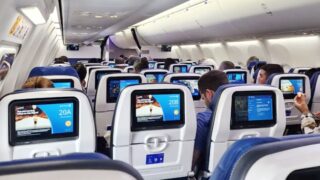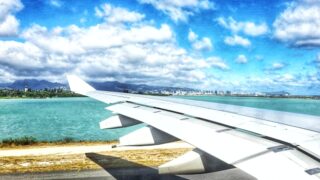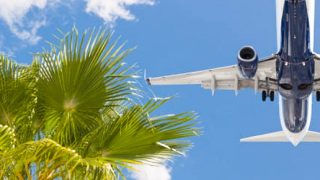Hawaiian Airlines took a giant leap forward by introducing free, high-speed WiFi powered by Starlink to its passengers, even on international routes. As the only major U.S. carrier currently offering this service, Hawaiian stands out, particularly on their trans-Pacific flights, including our recent international journey with them from Honolulu.
However, we recently learned that United Airlines might soon follow in Hawaiian’s footsteps, potentially altering the global landscape of in-flight connectivity. Here’s our review of Hawaiian’s Starlink service and how things could shape up next.


Easy access, awesome speed, near-seamless connectivity.
From the moment we boarded our flight from Honolulu to Tahiti, it was clear that the Starlink WiFi on Hawaiian was designed differently, seemingly with passengers in mind. After a brief announcement from the crew, connecting to the “Hawaiian Airlines WiFi” network was a simple, hassle-free process. No login was required, and the network was entirely ad-free, without even a typical airline landing page—a refreshing change from the often cumbersome logins and interruptions seen on other airlines.
The ease of connecting made the experience feel seamless, even for those who may not be tech-savvy. It was just like connecting at home. And once connected, we found additional benefits beyond the simplicity of the process.


High-speed free WiFi over the Pacific: Starlink delivered.
The performance of Starlink’s WiFi on our flight was nothing short of impressive. Passengers often expect slow, unreliable, and intermittent connections on overwater, international routes. However, Starlink stood out for its stability and speed, ranging from 130-175Mbps. Browsing websites, checking emails, and even streaming videos were like at home with minimal interruptions. While we did experience a few brief hiccups in connectivity, they were minor compared to what we’ve encountered with other in-flight WiFi services.
The WiFi remained consistent throughout almost all of the nearly six-hour flight,
No ads, just browsing: a premium experience.
One of the standout features of Hawaiian Airlines’ Starlink service is the absence of marketing. Unlike other airlines, which often require logging into frequent flyer accounts, navigating apps, or sitting through ads, Hawaiian’s service connects passengers directly to the internet. This streamlined approach greatly enhanced our enjoyment of the WiFi service.
This feature sets Starlink apart from others, though it’s uncertain if this ad-free experience will remain long-term. It’s also unclear whether this is an aspect of Starlink’s design or a decision by Hawaiian Airlines, but for now, passengers can appreciate how that works.
Starlink’s reach: setting Hawaiian apart, but for how long?
Hawaiian Airlines is currently the only major U.S. airline, aside from JSX, using Starlink for in-flight WiFi. This gives Hawaiian a distinct advantage, particularly on its trans-Pacific routes, where reliable connectivity can be a game-changer for passengers. Other airlines, including Delta and United, have struggled with a lack of connectivity between the US Mainland and Hawaii. International carriers ZIPAIR and Air New Zealand, both of which fly to Honolulu, have also adopted Starlink, offering their passengers the same high-speed WiFi access.
Is United Airlines moving to Starlink next?
Recent reports suggest that United Airlines might soon follow Hawaiian in offering Starlink WiFi. Reliable aviation source JonNYC on X recently hinted that United could soon announce Starlink as its new in-flight internet provider. This would make United the second major U.S. airline to adopt the technology, potentially reshaping the competition for premium in-flight connectivity. United currently has a hodgepodge of different paid WiFi options across its vast fleet.
Challenges for Starlink: Why haven’t some airlines adopted it yet?
Despite its initial success with Hawaiian Airlines, Starlink hasn’t yet dominated the aviation sector in the way it has transformed maritime WiFi connectivity. Recent reports identified several reasons for this, including concerns over the performance of Starlink’s antennas, which some airlines are said to have found unsuitable for the harsh conditions of flight.
Others have highlighted that Starlink’s lack of a customizable landing page—a key feature for airlines to monetize WiFi—may have deterred some carriers from adopting the service.
Lastly, it has been reported that Starlink has yet to offer the service level agreements (SLAs) airlines expect. Despite these challenges, airlines like Hawaiian, ZIPAIR, Air New Zealand, and airBaltic have found value in offering Starlink. If United joins them, it would signal a major shift in how U.S. airlines approach in-flight internet service.
Pacific Ocean coverage: is Starlink ready for more airlines?
Some have raised an interesting issue: a potential coverage gap on Starlink over some parts of the Pacific. Starlink satellites have reportedly begun using laser interconnects to relay signals over large bodies of water, helping to ensure more robust coverage. This connectivity is a crucial consideration for airlines like Hawaiian, which primarily operates flights over the Pacific. Should United move forward with Starlink, it will be interesting to see how they address this possible coverage challenge, particularly on Asia-Pacific routes.
Final thoughts on Hawaiian Airlines and the future of Starlink WiFi.
Hawaiian Airlines has positioned itself as a leader in in-flight connectivity by adopting Starlink. The free, high-speed, ad-free WiFi elevates the in-flight experience and differentiates Hawaiian from its competitors. However, with United Airlines potentially entering the Starlink space, competition may intensify.
For now, Hawaiian Airlines passengers can enjoy the best of what in-flight WiFi offers, particularly on its trans-Pacific routes between the Mainland and Hawaii. As the landscape of in-flight internet evolves, we look forward to airlines continuing to enhance their connectivity options for travelers.
Please share your thoughts on the state of airline WiFi.
Get Breaking Hawaii Travel News






You didn’t mention anything on Southwest. Are they going to Starlink, ever?
Given Starlink’s mercurial and often petulant CEO, Elon Musk, could an overreliance by the airline industry on Starlink potentially become a liability?
Hi Drew808.
There is Starlink competition that will be coming from Amazon, which is planning a more than 3,000 satellite strong broadband constellation.
Aloha.
That’s not only good to know, thanks! I firmly believe it will be good for everyone.
We just flew from OGG to LAX on Tuesday and it had Starlink and it was awesome. Thank you Hawaiian Airlines.
I think it’s great my wife and I will get to experience it later this month when we travel to Kauai. It’s just a shame that the owner is such an extremist, such a shame.
Any suggestions on which airlines to use flying from Honolulu to Singapore that offers lying flat seats for a long trip that doesn’t charge an enormous amount of money.
My husband and I really enjoyed the uninterrupted Wi Fi service by Starlink on our Hawaiian Airlines trip to Maui 2 weeks ago from OAK. We will be flying United SFO-FCO (Rome) in October; hopefully United will have Starlink by then. I work from home and our WiFi with Spectrum is so awful that we are considering switching to Starlink at home. It’s interesting; when we go camping in our travel trailer we have no problem with Wifi using a hotspot on our phone but can’t get reliable service at our house in Northern NV. Our biggest issue with Starlink is using the dish at home- we get a LOT of snow in the winter and it’s a pain to go out and brush off the dish- one of many reasons we dropped DirecTV for YoutubeTV.